Freedom Tower
Introduction
Text-to-speech Audio
Located on Biscayne Boulevard, the Freedom Tower is a 256-foot, seventeen-story Renaissance style building with Spanish Baroque embellishments. Construction began in 1924 and finished in 1925, and it served as the headquarters of the Miami News & Metropolis newspaper for over twenty-five years. In 1962, it was acquired by the United States government and used as a processing center for Cuban immigrants. During this period, the Freedom Tower acquired the moniker “Ellis Island of the South” and became an iconic representation of the aid offered to Cubans fleeing the dictatorship of Fidel Castro. Around 1.4 million Cubans came to the US, particularly Florida, for the chance of a better life. After the government ceased using the building in 1974, it languished before being restored in 1987. Today, the Freedom Tower serves as the site of Miami Dade College’s Museum of Art and Design.
Images
The Freedom Tower over the Miami Skyline
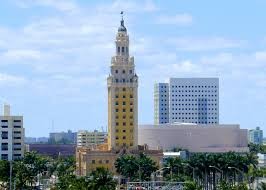
Cuban refugees in Miami after air lift, 1961
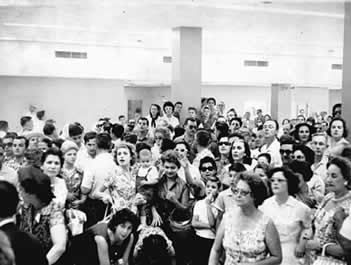
A young girl holds her doll as she arrives in the United States with the Operation Pedro Pan Program, circa 1960-1962.
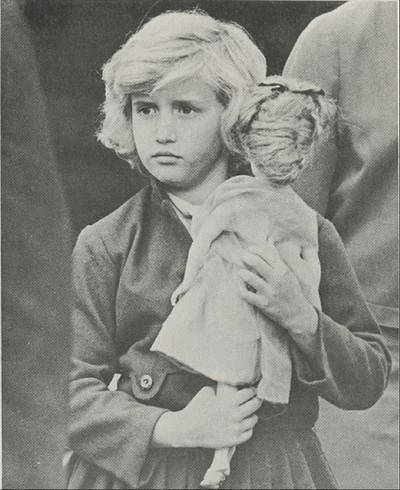
Cuban refugees arrive in Miami at the Freedom Tower.
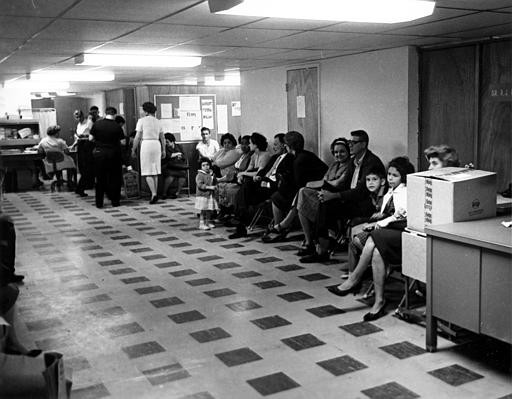
The New World Mural, which was faithfully copied from an original 1925 tapestry that could not be saved.
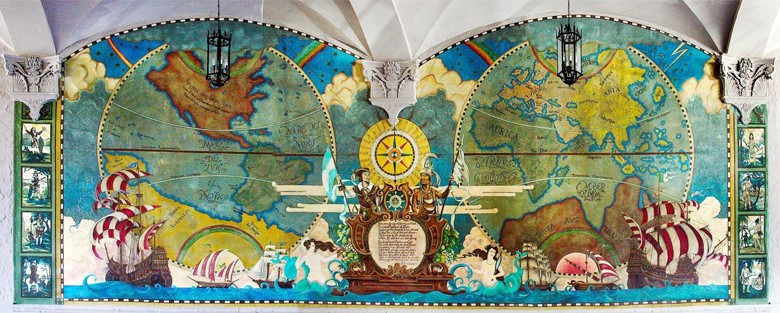
Charities gave used clothes to refugees
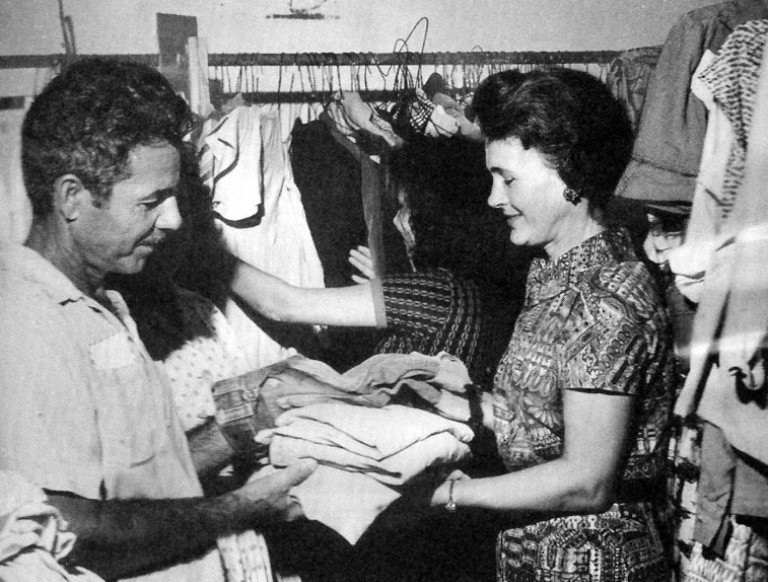
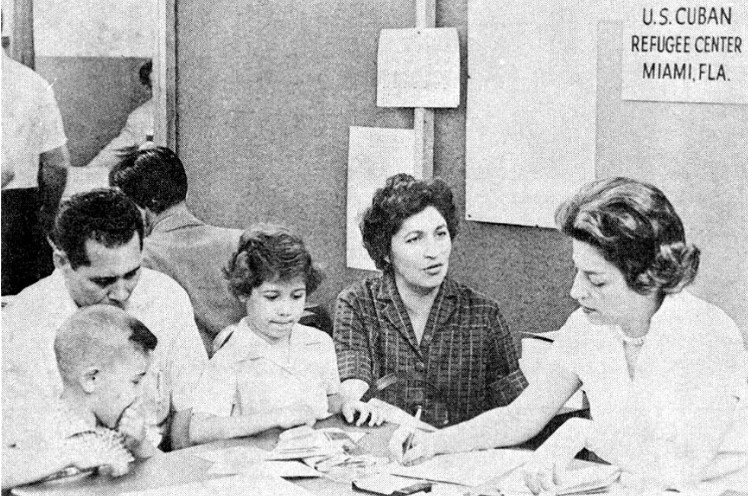
Backstory and Context
Text-to-speech Audio
The Freedom Tower is located in the heart of Miami, Florida. The seventeen-story building was inspired based on the design of the Giralda Tower in Seville, Spain. The Freedom Tower is blocky, with a three-story concrete base giving rise to a central steel-reinforced tower. Both the base and the tower are plastered with pink stucco. The stucco remains visible in many places but is offset by a generous coat of yellow paint. A two-story cupola caps the Tower. Windows are placed regularly throughout the structure and reflect a strong sense of symmetry. Due to the Spanish influence on the Tower’s design, the entrance and top of the structure display an abundance of detailing. However, most of the structure is relatively plain, with simple flat surfaces and the dichromatic pallet of pink and yellow used. The overall style of the structure resembles Renaissance building, though the artistic flourishes are clearly Spanish Baroque in nature.
In 1924, James M. Cox, owner of the Miami Daily News and Metropolis, approached the New York architectural firm of Schultze and Weaver. Schultze and Weaver had already established themselves as architects famous for creating Grand Central Station and Biltmore hotels across the country, in addition to many other projects. George A. Fuller was awarded the contract for construction and John B. Orr supervised the architectural details. The building cost $2 million – over $30 million adjusted for inflation. Construction began in winter of 1924 and was completed by Summer of 1925. Cox also commissioned a large tapestry for the building. The textile depicts Ponce de Leon and the Tequesta chief meeting before maps of the new and old worlds. Additionally, the tapestry includes a poem created by poet laureate Edwin Markham, famous for writing the Lincoln Memorial address.
To commemorate their new place of operations, the Miami Daily News printed the largest newspaper ever printed up to that point in 1925. It included 504 pages and weighed seven and a half pounds. The newspaper continued to operate from the Freedom Tower until 1957, when the Miami Daily News and Metropolis Company moved to a different building. The Tower sat empty for about five years before the United States Government took over the management of the building and turned it into a refugee center for Cuban immigrants fleeing Cuba. During the dictatorship of Fidel Castro, Cubans wanting to flee chose Miami due to its close proximity to Cuba. Many Cubans hoped that one day they would be able to return to Cuba. During this time, President John F Kennedy and his administration put together the Migration and Refugee Act of 1962. This act authorized the assistance to the many Cubans coming into the United States escaping Fidel Castro's dictatorship. Walter Entlig, the building manager, wanted this establishment to be recognized as a pillar of the American ideals of freedom and democracy, so he suggested renaming the building the “Freedom Tower”, or the “Ellis Island of the South.”
Under Castro's dictatorship, Cubans faced imprisonment, violence, fear, and even death. Leaving everything behind, a mass exodus of Cubans entered the United States when President John F. Kennedy enabled the Migration and Refugee Act of 1962. By the end of 1960, approximately 40,000 Cuban immigrants had fled to the United States. From 1965 to 1973, thousands more Cubans poured into the United States. Many escaped through maritime routes, although others chose to fly, especially through Pan American World Airways so-called Los vuelos de la libertad, or “Freedom Flights”. These were relief flights with the purpose of assisting immigrants, and they flew two planes per day, five times a week, from East Havana to Miami, starting in December 1965 to April 1973. In total, almost 300,000 were mobilized to the United States, despite a budget of only $12 million, and it became the “largest airborne refugee operation in American history”. The Freedom tower served as a turning point for many Cuban refugees. Refugees began to slowly rebuild their lives from scratch. The Freedom Tower assisted immigrants in doing so by providing the tools and resources necessary. The U.S government spent about $957 million on food programs, housing, employment, medical clinics and financial relief programs for Cuban immigrants.
The government only used the first four floors out of the 17 stories to help immigrants, and people arriving at the building for help received a number until they were called. Once this happened, they were given an identification card and went through an interview to assess their most urgent needs. Many of the workers at the tower, which became known by Cubans as El Refugio “The Refuge”, were Cubans, who helped people who did not speak English. In the basement, there was a “medical dispensary with physicians, dentists, and a pharmacy [...] and the people also received health screenings”, and it had a cafeteria with typical Cuban cuisine. Because of the large number of people arriving in Miami, job availability decreased, so the Cuban Assistance Center helped relocate refugees to other areas with better economic opportunities. In total, the government spent $957 million on the Cuban Refugee Program, and they closed the center in 1974. Due to its importance within the context of the Cold War and after helping the Latino community, the building was listed in the National Register of Historic Places.
For many years, the Freedom Tower sat abandoned and was allowed to decay. Vandals destroyed large amounts of the architectural details. In 1987, a restoration project restored the building to its former glory. During this project, the remains of the tapestry commissioned by Cox were rediscovered. Unfortunately, the tapestry was beyond conservation efforts, so a new replica mural was created by a group known as the Miami Artisans. The tower was sold multiple times to important businessmen like Sam Polur or corporations such as Citibank, Southeast Bank Trust, or Zaminco International. Yet, during this period, the building had many homeless people living in it, and suffered vandalism. In 1997, businessman Jorge Mas Canosa purchased the building for $4.1 million, with the idea of renovating it and consolidating it as a memorial for the families that fled Cuba. But once again, it was sold to the Pedro Martin family, who donated it to Miami-Dade College given its proximity to the tower and its status as the largest Hispanic-serving higher education institution. The building is now host to Miami Dade College’s Museum of Art and Design. Recently, Miami-Dade College established an exhibit in the tower that reflects the Cuban exile journey, now serving as a museum and cultural hub, which has a pedagogical goal of teaching the story of the events involving the tower, through exhibitions such as the Cuban Legacy Gallery and the Exile Experience. The state government also values the legacy of the tower: in 2022, Governor Ron DeSantis announced $25 million to preserve and renovate the tower, given its significance to the city.
Cite This Entry
MacKay, Iain and Philippe Joignant. "Freedom Tower." Clio: Your Guide to History. December 13, 2023. Accessed July 23, 2025. https://theclio.com/entry/15300
Sources
About the Freedom Tower.” MOAD, moadmdc.org/freedom-tower/about-the-freedom-tower.
Alberts, Heike. Changes in Ethnic Solidarity in Cuban Miami. American Geographical Society of New York, 2005.
Buss, Terry F., and Marcela Tribble. "Paradise lost? Miami, immigration and economic development." International Journal of Economic Development, vol. 5, no. 2, 2003.
Freedom Tower/Formerly Miami News and Metropolis Building, The American Institute of Architects. Accessed November 5th 2020. http://www.aiaflatop100.org/building.cfm?idsBuilding=7.
Freedom Tower, Florida, National Parks Service. Accessed November 5th 2020. https://www.nps.gov/places/freedom-tower.htm.
Freedom Tower, Miami Dade College. Accessed November 5th 2020. http://www.mdcmoad.org/freedom-tower/new-world-mural.aspx.
George, Paul. “Miami News Freedom Tower.” Miami History Blog, 30 Jan. 2023, miami-history.com/miami-news-freedom-tower/.
“Governor DeSantis Announces $25 Million Budget Proposal for the Freedom Tower.” Florida
Governor Ron DeSantis, www.flgov.com/2021/11/15/governor-desantis-announces-25-million-budget-proposal-for-the-freedom-tower/. Accessed 13 Dec. 2023.
Levine, Robert. Cuban Miami. Library of Congress, 2000.
“NHL Nomination.” National Parks Service, U.S. Department of the Interior,
www.nps.gov/subjects/nationalhistoriclandmarks/nhl-nomination.htm. Accessed 13 Dec. 2023.
“NPGallery Asset Detail.” National Parks Service, U.S. Department of the Interior, npgallery.nps.gov/AssetDetail/NRIS/79000665. Accessed 13 Dec. 2023.
Philipson, Lorrin. Freedom Flights. Random House Inc, 1980.
Rafferty, Jennifer Ashley. Building identity: The Miami Freedom Tower and the construction of a Cuban American identity in the post-Mariel era, University of Texas at Austin, 2012.
Strassburger, Robin R. Freedom Tower, National Register of Historic Places. May 31st 1979. Accessed November 5th 2020. https://s3.amazonaws.com/NARAprodstorage/lz/electronic-records/rg-079/NPS_FL/79000665.pdf.
Miami Dade College. Accessed November 5, 2020. http://www.mdcmoad.org/freedom-tower/new-world-mural.aspx.
https://www.latinamericanstudies.org/refugee-center.htm
https://www.latinamericanstudies.org/refugee-center.htm

